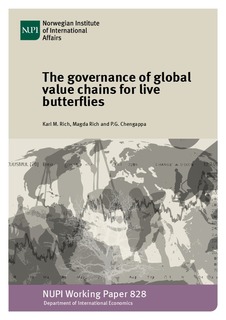The governance of global value chains for live butterflies / Karl M. Rich, Magda Rich and P.G. Chengappa
| dc.contributor.author | Rich, Karl M. | |
| dc.contributor.author | Rich, Magda | |
| dc.contributor.author | Chengappa, P.G. | |
| dc.date.accessioned | 2014-11-27T20:33:59Z | |
| dc.date.accessioned | 2014-12-03T10:21:14Z | |
| dc.date.available | 2014-11-27T20:33:59Z | |
| dc.date.available | 2014-12-03T10:21:14Z | |
| dc.date.issued | 2014 | |
| dc.identifier.citation | NUPI Working Paper 828 (2014) | nb_NO |
| dc.identifier.uri | http://hdl.handle.net/11250/226674 | |
| dc.description.abstract | Despite estimates that the global butterfly trade generates over US$100 million annually in sales of pupae for exhibitions and deadstock for a range of collector and artisanal uses, almost no research has been conducted that unpacks the dynamics of these value chains. This paper remedies this gap by highlighting the governance structure of the value chain, with important implications on the benefits for chain participants, upgrading strategies, sectoral sustainability, and the potential for new market entrants. Our research on live butterfly chains reveals the fragility of current modes of economic organization that promote overproduction as threatening the long-term viability for the industry as a whole. We propose an alternative governance model based on the use of individually transferrable quotas, or ITQs, as a means of improving the performance of certain butterfly value chains. | nb_NO |
| dc.language.iso | eng | nb_NO |
| dc.publisher | NUPI | nb_NO |
| dc.relation.ispartofseries | NUPI Working Paper;828 | |
| dc.title | The governance of global value chains for live butterflies / Karl M. Rich, Magda Rich and P.G. Chengappa | nb_NO |
| dc.type | Research report | nb_NO |
| dc.date.updated | 2014-11-27T20:33:59Z | |
| dc.source.pagenumber | p. 21 | nb_NO |
| dc.identifier.cristin | 1178085 |
Tilhørende fil(er)
Denne innførselen finnes i følgende samling(er)
-
NUPI Working Paper = NUPI Notat [304]
ISSN 0800-0018 -
Publikasjoner fra Cristin - NUPI [1400]
